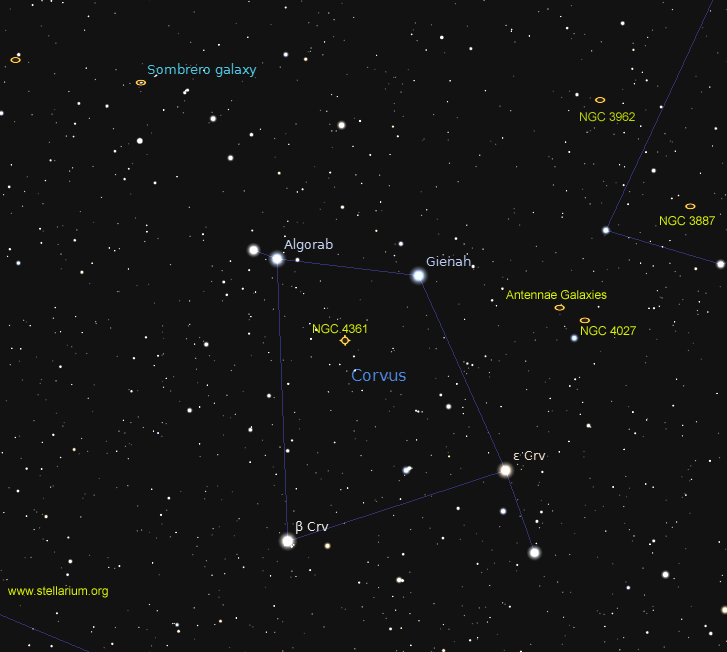Corvus The Crow
Corvus the Crow soars all night in southern skies. Four stars ranging from magnitude 2.5 to 3.0 form a somewhat crooked rectangle. If these are difficult to locate because of light pollution, the bright star Spica and planet Jupiter located to the upper left will point the way. The upper left star that is forming a wing is named Algorab. It is a double star located 86 light-years away and consists of a magnitude 2.9 yellow star along with a fainter magnitude 8,5 orange sun that appears more like yellow and lilac. They have a 650 AU separation meaning the fainter sun orbits once in 9,400 years.
One of the best examples of an edge-on galaxy is the magnitude 8.6 Sombrero Galaxy or M104. Technically it resides just over the border in Virgo. Never the less you must add this to your list of objects to see. M104 is a spiral galaxy located 31 million light-years away that reveals a fantastic dust lane along its outer edge. A combination of the ring and its large halo makes M104 a target for the eyepiece and the camera.

To the right, the four-star asterism is a pair of galaxies interacting with each other, a process that has been occurring for some 600 million years. In about 400 million years from now, they will have formed one larger galaxy. Know as the Antennae Galaxies, their catalogue numbers are NGC 4038 and 4039. This is the fate of the Milky Way Galaxy in four billion years as we become one with the Andromeda Galaxy. The Antennae reside 69 million light-years away and have a magnitude value of 10.5.
Towards the centre of the box is the only planetary nebula belonging to Corvus. NGC 4361 is an odd-shaped planetary nebula, looking more like a galaxy than the traditional shell of gas surrounding the white dwarf star – the fate of our Sun in four billion years from now. NGC 4361 only measures 1.8 arc minutes wide and glows at 10th magnitude.
The only meteor shower this month is the Eta Aquarid meteor shower. Your best chance to see some will be in the pre-dawn sky on May 5 and 6. Unfortunately, the shower produces only 30 meteors per hour and the southern hemisphere will be favoured to see more than here in the north.
There are presently three comets that should be easy to spot. First, we have C/2015 ER61 (PANSTARRS). Through most of the month, the comet travels through Pisces. At magnitude 7.4 it is still a binocular object and will pass close to Venus on 23rd. Another comet still putting on a good show in binoculars is 41P/Tuttle-Giacobini-Kresak. This one is a bit fainter at magnitude 7.7 and well placed in Hercules and glides by the Brilliant star Vega on May 3 on its way south. 41P is fading fast. The third and last of the somewhat brighter comets is C/2015 V2 (Johnson). This too starts from Hercules but moving west. At magnitude 9.1, you might need a telescope for this one. Towards the end of May, it should brighten a bit.
The brilliant planet Jupiter dominates the night sky and is well up in the east as the sunsets. From time to time the four Jovian moons have their individual turn crossing the planet’s cloud tops. Every so often a double transit occurs when two moons cross the same time leaving a double shadow. There will be three chances to see a double transit this month on May 11, 19 and 26. Please refer to page 233 of the RASC Observer’s Handbook 2017 for specific times.
The ringed planet Saturn is now visible from midnight local time. Seeing the rings in an eyepiece of a telescope is beyond words. Mercury is at its greatest western elongation at 26 degrees from the sun on the 17th. Venus is high in the eastern sky before sunrise.
Until next month, clear skies everyone.
Twitter: @astroeducator
Asteroid (22406) Garyboyle
